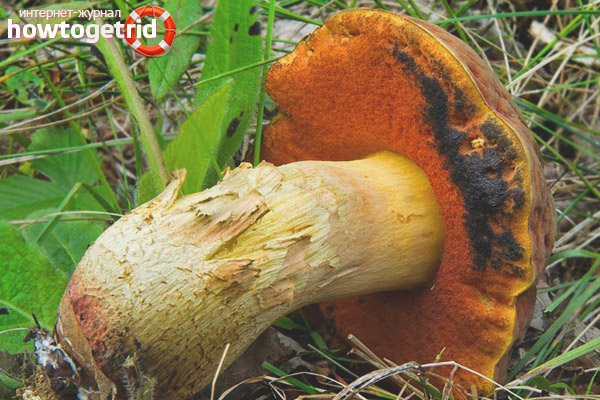The content of the article
The mushroom Dubele Kele belongs to the Boletovy family. They are edible.
Appearance
The shape of the hat is convex, without tubercles. It can be different in size, in diameter - 6-14 cm. The color is brown, sometimes it has a yellowish tint. The surface is dull, but after rain or in wet weather it becomes slippery and smooth.
The leg is firm, dense. In the lower part, it is somewhat swollen. Height varies from 6 to 11 cm. Usually the leg is colored yellow, on the surface there are small red scales. At the base, a white mycelium is visible. When pressed, the leg turns a little blue.
The pulp of representatives of this species is dense, yellow. When broken, it quickly turns blue. In this pulp, insect larvae are extremely rare. It has a faint smell and a slightly sour taste.
Where grows
Inedible Doubles
In appearance, the oak tree is very similar to the satanic mushroom. Confusing them is very dangerous, as Satanic is very poisonous. A distinctive feature of the Kele oak tree is that its flesh turns blue when damaged. He also has red pores, and red specks are visible on the leg.
Satanic mushroom can be distinguished by a pronounced strong smell. His hat is green with a gray tint. When damaged, the flesh also acquires a blue color, but soon returns to its original color again. The satanic mushroom has a tuberous pedicle, which is usually thicker than that of a cudgel. It shows a mesh pattern.
Cooking use
This mushroom can be eaten, but only in cooked form. They must be processed thermally. Only after this, substances irritating the digestive system will leave it.
These mushrooms are very nutritious, so they are used quite widely in cooking. They have fleshy flesh, have a pleasant smell. They are often salted, pickled, added to sauce, soup. To keep them longer, they are dried or frozen. But before you put it in the freezer, you need to boil them. They almost do not boil, retain beneficial substances.
Medical use

The benefit is that this mushroom helps increase immunity due to the fact that they contain beta-glucans. Eating mushrooms prevents the development of tumors. They help with depression and chronic fatigue.
Amino acids improve memory and prevent atherosclerosis. From these mushrooms make tinctures and other means.
Precautionary measures
Since any mushrooms contain chitin, which children are not able to digest, it is better to start using them only after 12 years.
Before use, it is recommended to soak the oak tree by draining the water several times. If this is not done, then the substances contained in these mushrooms will have a bad effect on digestion.
What kindred mushrooms exist
Burroughs boletus is also a suitable relative of the oak tree. His hat is big and fleshy. At first it is rounded, and then it becomes flat. It can be white or gray. Sometimes there are specimens with a brownish hat. The leg is white, and the pulp is quite dense. It has a rather pronounced aroma, and the taste is sweetish. You can see representatives of this species in the forest. They grow in North America. Often grow in large groups. In Europe they do not grow.










Submit